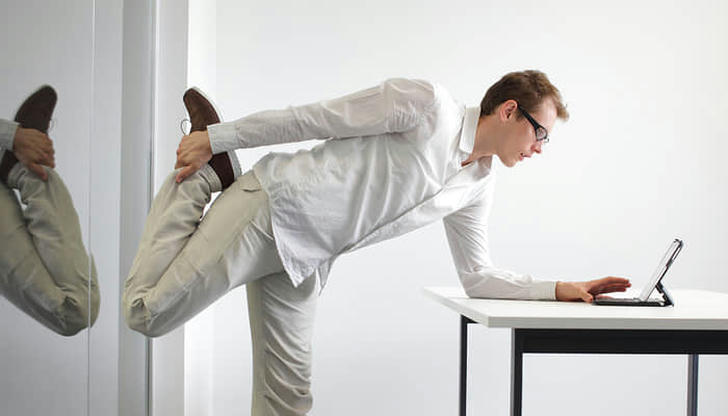The Terrifying Truth About Sitting: How to Escape the Dangers of a Sedentary Lifestyle
Advertisement

Sitting or lying down might seem like the ultimate way to relax and unwind, but too much of it can be a ticking time bomb for your health. It's time to wake up to the alarming consequences of our sedentary habits.
According to the World Health Organization, nearly 2 million deaths each year are linked to sedentary lifestyles, often dubbed 'Sitting Disease' or 'Couch Potato Syndrome.' The research is clear: prolonged sitting and inactivity can lead to severe health issues, including obesity, diabetes, high blood pressure, high cholesterol, heart disease, osteoporosis, depression, anxiety, and even certain cancers.
The threat is real, but the good news is you can take action. Adding more movement to your daily routine can significantly boost your physical and mental health, enhance your sleep, and potentially extend your lifespan. Here are ten simple yet effective ways to fight against a sedentary lifestyle and reclaim your health:
1. Don't look at the screen too long time

In our screen-dominated world, it's crucial to break free from the cycle of continuous staring. Whether it's binge-watching TV or a long workday in front of the computer, taking regular breaks is essential to safeguard your well-being.
During TV time, make it a habit to stand up during each commercial break. At work, step away from your computer screen at frequent intervals – perhaps a short walk for water, a stroll around the office, or a quick chat with a coworker can make a big difference.
If you struggle to remember to take breaks, try setting a reminder on your phone or placing a sticky note at eye level on your screen. These simple actions can help you combat sitting and maintain a healthier balance in your daily routine.
2. Ditch the Chair

Swap sitting for standing whenever possible – whether you're watching TV, in meetings, at your desk, or on calls. Many workplaces now offer standing desks, proven to combat fatigue and enhance productivity. Consider discussing the benefits with your HR department to see if it's a fit for you.
3. Walking for Better Health

Don’t just stand up – get those feet moving! Countless studies highlight the health benefits of walking, like lowering the risk of heart disease, boosting immune function, and reducing stress and blood pressure. Whether you’re at work, school, home with kids, or simply lounging, there are plenty of ways to add more steps to your day. Take a brisk walk around the block during lunch, pace around while on calls or during TV breaks, and even march in place while waiting for the microwave or brushing your teeth. Parking farther away at the store or school drop-off adds up too. These small changes may seem minor, but every bit of movement counts toward a healthier you.
4. Opt for the Stairs

Skip the elevator and escalator! Instead, choose the stairs to boost your health. Climbing stairs gets your heart pumping and benefits your muscles, bones, joints, and lungs. Research shows that even a few minutes of stair climbing daily can enhance your fitness levels. Stairs are readily available in most places, making them a convenient and cost-effective way to increase your physical activity. So next time you have the option, take the stairs and feel the difference in your health!
5. Turn Chores into Exercise

Ever noticed yourself breaking a sweat after sweeping, organizing, or scrubbing? It's easy to overlook how much of a workout household chores can provide. These tasks not only maintain a clean home but also keep you physically active. Instead of seeing chores as a burden, consider them opportunities for daily movement. Whether wiping down counters after meals or vacuuming with a bit more vigor, every chore can add to your daily activity level. So, next time you're tempted to procrastinate, think of it as a chance to boost your fitness while keeping your home in top shape!
6. Desk Exercises for a Healthier You

Sitting for prolonged periods can pose health risks, but fitting in exercise at your desk doesn't have to be awkward. You can perform some simple and effective exercises without any special equipment right from your office chair, which can get you moving and active.
7. Transform Your Commute for Better Health

Aside from the sedentary nature of your job, your commute likely adds more hours of sitting each day. Whether you're driving or taking public transport, you're spending a significant amount of time seated.
One effective way to combat this is by incorporating cycling or walking into your commute. Both options offer numerous health benefits and contribute positively to the environment. They help you stay active throughout the day and reduce the stress associated with traffic.
8. Stay Active Beyond Office Hours

Even if you've implemented changes like taking stairs or biking to work, it's challenging to entirely avoid sitting during office hours. Therefore, it's crucial to minimize sitting time outside of work.
Instead of collapsing on the bed or sinking into the couch like a couch potato, engage in activities that keep you moving. Consider hitting the gym for a workout session, going for an evening stroll, or pursuing any activity that reduces your sitting time. These actions not only counteract the sedentary effects of your workday but also promote overall health and well-being.
9. Gardening

According to the American Heart Association, general gardening falls into the category of moderate-intensity physical activities, offering numerous health benefits.
If you have space, start your own garden at home. It's a gratifying way to nurture plants and reap the rewards of fresh produce or colorful blooms. Alternatively, consider volunteering at a local community garden. Many urban areas, schools, and nature centers welcome volunteers to help with planting and upkeep.
10. Manage Your Intake

Calories come freely, but excessive consumption can burden you with unwanted weight. Sedentary lifestyles compound this issue as sitting doesn't burn calories. The key to managing this is straightforward: prioritize hydration over excessive eating.
Opt for smaller portions during meals. Controlling cravings, especially for food enthusiasts, can be challenging yet achievable. Focus on satisfying your hunger with balanced meals and replace mindless snacking with water intake. This approach not only supports healthy eating habits but also helps in maintaining a balanced calorie intake for a healthier lifestyle.



